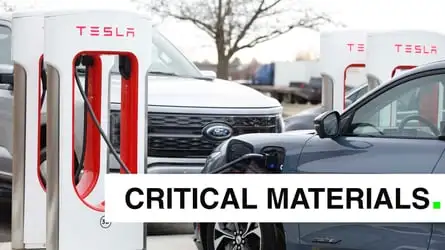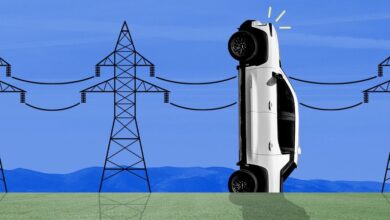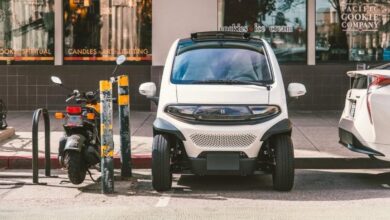Maybe The Used EV Market Is Just Becoming More Normal

Is the used EV market “crashing,” or just into business as usual? Plus: Polestar expands, and so do Chinese cars in Mexico.

Jun 17, 2024 at 10:29am ET
If you want to buy a used electric vehicle, there’s never been a better time than right now, in the summer of 2024. As a consequence of last year’s aggressive price wars, cooling overall car demand, high interest rates and persistent concerns about charging, EV prices are way, way down from from their historic highs. But is this another sign of doom and gloom, or just normalization?
That leads off this summer Monday edition of Critical Materials, our morning roundup of what’s hot in the EV, tech and mobility world. We hope you’re staying cool out there too, especially as the Chinese automakers bring the heat in Mexico and Polestar has an eye for growth. Let’s dig in.
30%: The Used EV Market Is Starting To Feel… Normal?
Used EV prices over time. Source: iSeeCars
I’m not a conspiratorial person—not any more than I should be living in America in 2024, anyway—so I tend to chalk a lot of overtly anti-EV news stories up to editors finding stuff that clicks, rather than some grand plan to undermine the transition away from gas-powered cars. But there are different ways to look at this used EV price slide we’re seeing right now. Check out the latest data from iSeeCars above and you’ll see how down those prices are from even last year.
Here’s CNBC to elaborate:
The decline has been dramatic over the past year. In June 2023, average used EV prices were over 25% higher than used gas car prices, but by May, used EVs were on average 8% lower than the average price for a used gasoline-powered car in U.S. In dollar terms, the gap widened from $265 in February to $2,657 in May, according to an analysis of 2.2 million one to five year-old used cars conducted by iSeeCars. Over the past year, gasoline-powered used vehicle prices have declined between 3-7%, while electric vehicle prices have decreased 30-39%.
“It’s clear used car shoppers will no longer pay a premium for electric vehicles,” iSeeCars executive analyst Karl Brauer stated in an iSeeCars report published last week. Electric power is now a detractor in the consumer’s mind, with EVs “less desirable” and therefore less valuable than traditional cars, he said.
I’lll dispute the “less desirable” part right there, and I’d ask which “consumer” that’s even referring to. The point is this: buyers are no longer willing to pay the price premium they once did for EVs, but they also no longer have to. And new EV prices are down too.
In other words, isn’t this a sign that that the market is becoming more normal? That electric cars are often just becoming cars, and not expensive luxury items meant only for wealthy buyers? After all, with Tesla prices being as low as they are and a glut of affordable new options like the Chevy Equinox EV, it’s cheaper than it’s ever been to break up with gasoline.
Let’s remember that the car market itself—all of it, gas or electric—is in weird shape right now, and a lot of that is due to high interest rates. Prices were down in Q1 and automakers are worrying about rising inventory levels, including with their gas-powered trucks, which has several of them really freaked out.
What we know is that on the electric side, you have more choices than ever, from more brands than ever, that have been on sale for longer than ever, at a time when the overall segment is in between growth waves. Of course prices are down. Now’s a good time to take advantage of that situation.
60%: Polestar Plans To Launch In Eastern Europe, Thailand, Brazil
Geely Group-owned EV brand Polestar has had its fair share of struggles over the last two years or so. But even with corporate cousin Volvo cashing out, slowing Polestar 2 sedan sales, a tanking stock price and the rise of oddly similar but similarly more successful related operation Zeekr, the Geely mothership still has big plans for the brand.
As more Polestar models arrive to rescue those sales, the brand announced today that it’s expanding into several new markets:
Polestar is accelerating its geographic expansion and plans to enter seven new markets during 2025. France is the largest volume market for electric cars in the EU after Germany and represents a significant opportunity for the company. In addition, Polestar will look to launch in Czech Republic, Slovakia, Hungary, Poland, Thailand and Brazil via local distribution partnerships.
Thomas Ingenlath, Polestar CEO, says: “Expanding our retail operations with new and existing partners will enable us to reach more customers. Through these partnerships and expansion, we will capitalise on our strong brand and growing model line-up.”
Geely seems to be doubling down on Polestar, despite everything. Is that the right move?
90%: One In 10 Cars Sold In Mexico Is Chinese Now
But Geely’s plan for Polestar also speaks to the Chinese automakers’ approach to winning: scale, scale, scale. Be in as many markets as it possibly can be, all of the time. Tariffs keep those cars out of the U.S. for now, but car companies from China are swiftly taking over the rest of the world.
Case in point: Yahoo Finance reports that now one in 10 cars sold in Mexico are from a Chinese automaker. Seven such brands went on sale in Mexico just last year. Note that those sales aren’t entirely EVs, of course, but we all know that’s where China’s automakers are playing the long game.
And it’s thought to be only a matter of time before those cars start getting built in Mexico as well, which would give them a theoretical door into the U.S. market too, since so many of our cars are built there already:
“Almost overnight, we started seeing Chinese cars driving in Mexico,” said Juan Carlos Baker, Mexico’s former vice minister for foreign trade. “In terms of how often you see them and how aggressive their marketing and sales campaigns have been on the part of Chinese cars, that is really pretty evident.”
However, calls to curb Chinese EV makers in the U.S. and Mexico have intensified recently in response to increased imports and investment. According to Baker, who played a critical role in crafting the USMCA, the threat of cheap Chinese EVs flooding the market never emerged as a concern in the two years the trade pact was being negotiated.
“I was present in every single meeting, and I don’t remember once Ambassador Lighthizer or anyone at [the U.S. Trade Representative office] saying, ‘We need to make these rules of origin or other elements very strict because the Chinese are coming,'” he said.
Although Baker noted that no Chinese carmaker has started manufacturing vehicles in Mexico yet, the country’s proximity to the U.S. has raised particular alarm in Washington. Lawmakers fear auto companies will use the country as a backdoor to skirt U.S. tariffs on Chinese car imports, which President Joe Biden raised to 100% last month.
If BYD and the rest come to the U.S. someday, I’m fairly sure it will be with cars built in Mexico first.
100%: Should You Buy A Used Or New EV Right Now?
If you’re in the market for an EV this summer, are you considering a new or used purchase? What’s caught your eye lately? Alternatively, what would you recommend to other buyers right now? I think the new leasing deals we’re seeing right now are too good to pass up, but leasing isn’t for everyone.
Contact the author: patrick.george@insideevs.com
Read more



